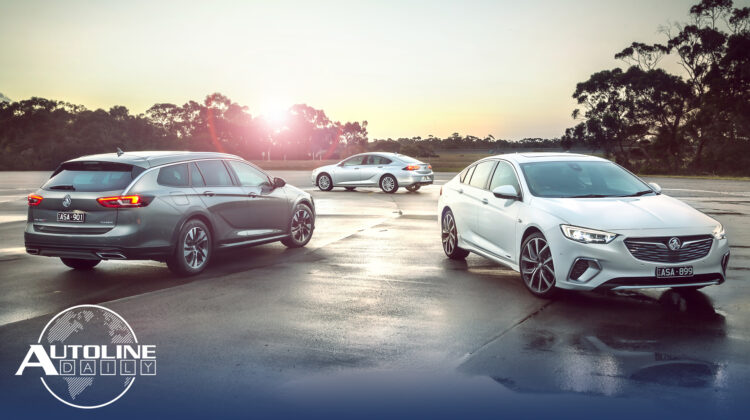

Follow us on social media:
Runtime: 9:40
0:08 GM Shuts Down More International Operations
0:52 Australia Is a Tiny Car Market
1:28 Tesla’s Sales Up in Germany
2:29 Ford Using VR To Train Mustang Mach-E Techs
3:26 Kia Unveils New Sorento
4:12 U.S. Sales Expected to Remain Strong Through 2023
4:57 VW Offers €830 Million To Compensate Diesel Owners
5:25 Volkswagen Cuts CO2 Emissions 60% At Wolfsburg Plant
5:49 Why Detroit Automakers Lack Entry Level Vehicles
6:55 How GM’s OTA Updates Work
Visit our sponsors to thank them for their support of Autoline Daily: Bridgestone and BorgWarner.
This is Autoline Daily, the show dedicated to enthusiasts of the global automotive industry.
GM SHUTS DOWN MORE INTERNATIONAL OPERATIONS
General Motors announced its winding down more of its international operations. It will phase out its sales, design and engineering operations in Australia and New Zealand as well as retire the Holden brand by 2021. In addition to that, GM is selling its Rayong plant in Thailand to Great Wall Motors and it’s pulling the Chevrolet brand from the Thai market by the end of this year. GM CEO Mary Barra says the restructuring will help pay for investments in electric and autonomous vehicles. The company is prioritizing profit margins over chasing market share. It’s disappointing to see GM abandon the Australian market where it’s been building Holden’s since 1948.
AUSTRALIA IS A TINY CAR MARKET
Keep in mind that Australia is a small market. It has a population less than the state of Texas and buys fewer new cars than Texas. It’s really impossible to maintain a domestic auto industry based on that volume, unless it’s heavily protected by tariffs. That’s how the industry flourished in Australia. At one time tariffs were over 50% on imported vehicles. Today it’s 5%. And while low tariffs have been a great benefit to Australian car buyers, it destroyed their domestic auto industry.
TESLA’S SALES UP IN GERMANY
We’re slowly getting more sales reports out of Europe, and as you’ll remember, we’re very keen to see how Tesla is doing. We want to see if it can make up for a sales slide in the U.S. with strong sales in other markets. So far we’ve seen big drops in Norway, the Netherlands and Spain, and big percentage increases in Canada and France. Wards Intelligence just reported sales for Germany in January, and the overall market fell 7%. Tesla was up 168%, but don’t get too excited. The numbers are very small. While the increase was big, Tesla only sold 367 cars in Germany last month.
FORD USING VR TO TRAIN MUSTANG MACH-E TECHS
Ford is teaming up with Bosch to help its technicians learn how to work on the all-new Mustang Mach-E. The training will provide workers with Oculus Quest virtual reality headsets that will immerse them in a simulated and gamified world. While this video is not the exact system, it does give you an idea of how technicians will be able to learn about parts and components. They’ll first learn how to diagnose and service the EVs high-voltage system, like how to remove, service and maintain the battery pack. But Bosch is also working on future updates that will allow workers to navigate through the vehicle’s modules to help determine what is causing an issue. One of the advantages to using virtual reality is that you don’t need a physical vehicle to perform the training and Ford hopes that high-tech solutions like this will help attract new hires to the automotive repair world.
KIA UNVEILS NEW SORENTO
Kia is revealing the all-new Sorento, which is built on an all-new platform. We think the design is more premium and rugged looking than the outgoing model. The large side curtain vents, design elements on the front doors and fenders as well as the treatment around the exhaust are what gives it that more premium feeling. And the blocky grille and rear taillights have a rugged effect. Also notice the little shark fin in the rear side window, which gives it a unique shape. The interior on this model has a nice two-tone look with a diamond stitched pattern in the seats. But the focal point is a new ten and a quarter inch infotainment screen, which is flanked by a 12.3-inch digital instrument cluster.
U.S. SALES EXPECTED TO REMAIN STRONG THROUGH 2023
New car sales are expected to remain strong for the next several years. Wards reports that the chief economist for the National Automobile Dealers Association forecasts sales will be above 16 million units in the U.S. through 2023. While that is good news for automakers, he is predicting sales will drop a few hundred thousand units each year. High prices for new vehicles will continue to drive consumers into the used car market.
VW OFFERS €830 MILLION TO COMPENSATE DIESEL OWNERS
Volkswagen is still paying for its diesel emission cheating nearly five years after the scandal was revealed. The German automaker is offering to pay 830 million euros to compensate owners in Germany, where it’s involved in a class-action lawsuit. But it’s not clear if the deal will be accepted because the consumer group representing owners says the company needs to come up with a better way for owners to receive a settlement.
VW CUTS CO2 EMISSIONS 60% AT WOLFSBURG PLANT
And speaking of VW and emissions, Reuters reports the automaker is shutting down two coal-fired power stations at its main factory in Wolfsburg, Germany. It’s replacing them with turbine gas plants, which will cut CO2 emissions by 60% at the plant. VW says it’s had offers to buy the coal plants but declined to sell them for environmental reasons.
WHY DETROIT AUTOMAKERS LACK ENTRY LEVEL VEHICLES
We keep hearing complaints in the media about a lack of entry level vehicles in the U.S. market, especially from GM, Ford and FCA. Here’s our Autoline Insight: they can’t make money on cars that cost less than $20,000–not with UAW labor, that is. Some say they should just bite the bullet and sell entry level cars at a loss because they need to bring new buyers to their brands. But imagine you’re a program manager and you go to the board of directors and ask them to give you hundreds of millions of dollars to develop a new car. And then you tell them they’ll never see any return on that investment. They’ll throw you out of the meeting. Detroit’s automakers destroyed tens of billions of dollars in shareholder value in the last three decades by investing in products that never returned a dime. That’s a key reason why two of them went bankrupt, and why they will never do that again. So if you ran a car company what would you do? Invest in a money loser, or abandon the segment?
HOW GM’S OTA UPDATES WORK
Last year, General Motors introduced a new electronic architecture for its vehicles. It’s in a few vehicles already but it will roll out to most of its lineup by 2023. The new platform makes it possible to add next-gen technology to its vehicles. And one of those new features is over-the-air updates. And on last week’s Autoline After Hours, Gary Bandurski from GM explained how those OTA updates work.
Gary Bandurski, General Motors
“For cyber security reasons what we do is, the way we partition our vehicles, we have a gateway. And that helps control what can come in and what can come out. And we have the ability over-the-air to communicate with that gateway and once you get on that particular gateway and get on those buses, you have the ability to communicate with specific modules and update or enhance software and calibrations that they have. And so, in the past when you didn’t have over-the-air capability, you would have to sometimes replace the module in the vehicle because you didn’t have an opportunity to re-flash it as we say or the next step on that was maybe tie in on the ALD connector that you see at your dealership sometimes. The dealer will hook up a piece of equipment to check what’s going on with your car and be able to update the vehicle and we got a lot more sophisticated. Just like what happens with your phone when you get updates over-the-air. Ping you as a customer, say we have an update that we’d like to do, get your concurrence in order to do that. And it doesn’t necessarily right at that point allow it to happen because when you do an over-the-air update of course the vehicle needs to sit for a little bit. You need to power it up and you got to make sure that the vehicle, at least the state of charge of the battery is such that it’ll be able to power up, use the power, update the system, shut the system back down, hand it back to the customer and make sure they’ll be able to start their car and go. And if we determine its not ready in those particular cases, we’ll have to come back another time and ask the customer if they want to do it or of course they can take it to the dealership to have it done as well.”
For a deeper dive into GM’s new electronic architecture you can watch that show right now on our website Autoline.tv or you can find it on our YouTube channel.
But that wraps up today’s report, thanks for watching and we’ll see you again tomorrow.
Thanks to our partner for embedding Autoline Daily on its website: WardsAuto.com

John McElroy is an influential thought leader in the automotive industry. He is a journalist, lecturer, commentator and entrepreneur. He created “Autoline Daily,” the first industry webcast of industry news and analysis.




